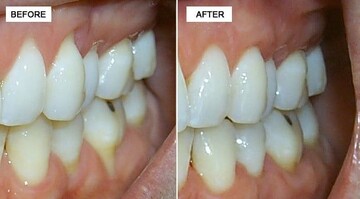Periodontics
Tooth loss occurs for many reasons; dental decay, root canal problems, fractures, periodontal disease and trauma. Additionally, at times teeth never develop. As a result of tooth loss, the bone melts away.
Bone grafting materials are used to rebuild and regenerate the bone providing sufficient bone in quantity and quality for implant placements and supporting tooth structure.
When deep pockets between teeth and gums (6 millimeters or deeper) are present, it is difficult for a dentist to thoroughly remove the plaque and tartar. Flap surgery is a procedure where the gum flap is lifted away from the tooth. Diseased tissue and sometimes bone is removed. The rough surfaces of the tooth are then smoothed by root planing. The area is medicated and the gum flap is replaced and sutured allowing the bone and gum tissue to heal. One of the goals of flap surgery is to reduce the depth of the periodontal pockets to make them easier to keep clean.
If a patient has an excess amount of tissue that connects the lower and upper lips to the jaw and gum line, a frenectomy procedure is performed to remove the excess tissue.
Periodontal procedures are available to lay the groundwork for restorative and cosmetic dentistry and/or to improve the esthetics of your gum line. Your teeth may actually be the proper lengths, but they are covered with too much gum tissue. Crown lengthening is a procedure to correct this condition.
During this procedure, excess gum and bone tissue is re-shaped to expose more of the natural tooth. This can be done to one tooth, to even your gum line, or to several teeth to expose a natural, broad smile.
Crown lengthening can make a restorative or cosmetic dental procedure possible. Perhaps your tooth is decayed, broken below the gum line, or has insufficient tooth structure for a restoration, such as a crown or bridge. Crown lengthening adjusts the gum and bone level to expose more of the tooth so it can be restored.
The best material for a bone graft is your own bone, which most likely will come from your chin, the back part of your lower jaw or your hip bone. The hip is considered to be a better source because the hip bone has a lot of marrow, which contains bone-forming cells. There are also synthetic materials that can be used for bone grafting. To place the removed bone in the recipient site, little holes are drilled in the existing bone to cause bleeding. This is done because blood provides cells that help the bone heal. The block of bone that was removed will be anchored in place with titanium screws. A mixture of the patient's bone marrow and some other bone-graft material will then be placed around the edges of the bone block. Finally, a membrane is placed over the area and the incision closed. The bone graft will take about 6 to 12 months to heal before dental implants can be placed. At that time, the titanium screws used to anchor the bone block in place will be removed before the implant is placed.
Tooth loss occurs for many reasons; dental decay, root canal problems, fractures, periodontal disease and trauma. Additionally at times teeth never develop. As a result of tooth loss the bone melts away. If there is inadequate bone to support surrounding teeth and future possible dental implant(s), bone grafting materials are used to rebuild and regenerate the bone providing sufficient bone in quantity and quality for implant placements and supporting tooth structure.
When a tooth is lost and not immediately replaced, the bone reacts to this event by 'shrinking back'. The bone becomes thinner from a width perspective and the bone height is frequently reduced. This process is known as bone resorption. In order to place implants, it is necessary to rebuild the bone width and height through regenerative surgical therapy. Bone grafting of the ridge is almost always required to enable accurate placement of dental implants. The grafting is completed utilizing tissue bank and/or synthetic bone particles combined with collagen membranes. It is a highly predictable procedure.
In the back of the upper jaw bone dental implants are frequently needed. In order for a dental implant to be successful in this area of the mouth there must be sufficient bone height and width to connect (integrate) to the dental implant. When the upper back teeth are lost and not replaced the sinus cavity becomes enlarged destroying any bone that is left behind. This very large sinus is like a "giant air pocket" and not capable of supporting an implant. A procedure known as sinus grafting (sinus lift) is performed to create bone that will ultimately hold the implants within the sinus. Sinus grafting is an extremely common form of bone grafting.
In the back of the upper jaw bone, dental implants are frequently needed. In order for a dental implant to be successful in this area of the mouth there must be sufficient bone height and width to connect (integrate) to the dental implant. When the upper back teeth are lost and not replaced, the sinus cavity becomes enlarged destroying any bone that is left behind. This very large sinus is like a "giant air pocket" and not capable of supporting an implant. A procedure known as sinus grafting (sinus lift) is performed to create bone that will ultimately hold the implants within the sinus. Sinus grafting is an extremely common form of bone grafting.
When a tooth is extracted and an implant is to be placed (either simultaneously or in the future) it is always necessary to complete bone grafting within the residual sockets that are left behind after the roots of the tooth are removed. The shape of the tooth root is always different from the shape of a dental implant and hence there are always residual socket defects (holes) that must be filled in so that there can be excellent contact of the implant to the newly formed bone.
Root exposure resulting from gingival tissue recession may pose multiple problems for patients:
- Undesirable Aesthetics
- Root Sensitivity
- Impaired Oral Hygiene
- Increased Caries Susceptibility
- Teeth May Become Loose
A gingival tissue graft will restore the proper gum tissue structure around the tooth.



